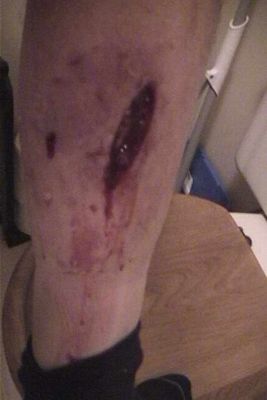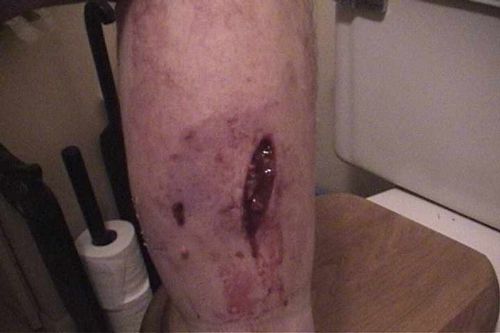
Please send us your comments on the following photos 
Dog bites
Pit Bull bites



Last night, I had the misfortune of sustaining a bite from a pit-bull. To make the best of a bad situation, I photographed the wound as it is a perfect example of a dog-bite, and not a cat-bite. The wound itself is similar to some of the bites found on sheep where the hide was ripped open and the animal disembowelled. Cats puncture with repeated bites or claws, and such ripping is virtually impossible.
The images can be viewed and an interesting comparison can be made concerning some of the sheep kills. Fortunately, my injuries should heal without any residual affects.
There were only four stitches and the fabric in the pants I was wearing was barely torn. The problem was all the muscle and flesh that was shredded.
Hard to believe, but today it's hardly sore and there's almost no swelling at all. I think it's probably the worst bite I've ever had though, and that includes a lion twenty-five years ago.
It's a perfect example of how certain dog-bites rip, where cats cannot. Even here, I didn't realize until yesterday that the dog broke one canine and pulled out three inscissors during this bite, so there was something very disturbing to cause this sort of behavior.
Ben Willis, Scottish Big Cats
The Discovery Channel showed a very interesting program last night on shark attacks. The analysis on bites and the recent report and conclusion on the dead cats in Utah has given me a better perspective as matching teeth marks against the wounds they cause.
Since my unfortunate incident with the pit-bull bite two weeks ago, I've puzzled as to how the wounds I sustained might have been caused by one single bite. The Utah report explained how tears in the flesh can closely resemble the precision of a scalpel cut. In the case of my wound, there appeared to be the same straight gash, along with several punctures matching the normal teeth marks seen in animal bites. In most circumstances, this type wound would be attributed to multiple bites by the animal. In this case however, I distinctly recall one single bite which happened so quickly that the dog had vanished before I was able to turn toward it.
Still though, the wound that I photographed and have had two weeks to observe closely has marks indicating all the canines as well as the lower inscissors. It is most unusual to find marks from both upper and lower canines, and it indicates extreme pressure. What I found puzzling was the long gash which didn't match any teeth marks whatsoever. This was somewhat explained in the shark footage that simulated reactions of human flesh when subjected to the mass pressure of a shark bite. This causes splits to occur in the flesh in areas where the teeth never touch. The result is a large gaping wound that follows no pattern of bite mark and would appear as straightly opened as if it were sliced. Based upon that principal, it provides an answer as to the marks I see in my own wound.
Ben Willis, Scottish Big Cats
 |
 |
 |
| Return to index | Return to Scottish Big Cats | Return to Photo Album |